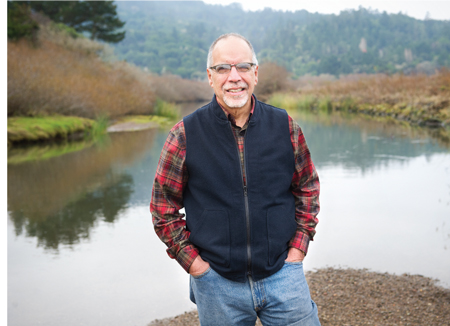Sometimes it’s funny how things turn out in life. Take Steve Costa, a burly 63-year-old who spent 40 of his prime working years as an inner-city community organizer. He aided a nonprofit in the South Bronx, served on the staff of a California congressman and helped the Trust for Public Land develop communal gardens in downtown Oakland.
Costa’s role was to bring people together, to create a constituency or sense of community. Until recently, it was always an urban community.
“Then in the 1990s,” he recalls, “as we began spending time in Point Reyes Station, I realized I could apply my knowledge, experience and love of community in a small town every bit as well as I could in a big city.” A small town, after all, was in some respects like a city neighborhood. So what did he do? In 1998, Costa and his wife, Kate Levinson, moved to Point Reyes Station, and within three years, they’d bought the town’s only bookstore.
“We had never owned a business; we had no retail experience,” says a smiling Costa. “Absolutely none.” But they thought a bookstore could be an excellent community-building mechanism. “Bookstores, like nonprofits, bring people together, and we had plenty of experience running nonprofits,” Costa says, still smiling. “And bookstores rarely make a profit—so it was perfect.”
Actually, nearly nine years later, Point Reyes Books is turning a tidy profit. Last year it sponsored 42 book signings, 14 of which raised over $45,000 for local nonprofits, often featuring nationally recognized authors like Colm Toibin, Jane Smiley, T. C. Boyle and Robert Reich.
In 2008, Costa and a handful of West Marin residents, including former U.S. Poet Laureate Robert Hass, poet and peace activist Brenda Hillman, and environmental historian Philip Fradkin, took the organizing up a notch by holding the first Geography of Hope Literary Conference. “Books serve as a catalyst for bringing people together,” Costa says, “and the Geography of Hope conference takes this to the next level. It’s an opportunity for people to come to the special place of West Marin and spend a weekend interacting with creative minds.”
This year’s Geography of Hope is more than a weekend—it includes not just a literary conference but a film festival and 10 public art installations (see sidebar). “So 40 years later and I’m still a community organizer,” Costa says a bit sheepishly. “Only now it’s in a rural, not an urban, setting.”
What has surprised you about working in a rural environment? Working in Point Reyes, surprisingly, we see a greater emotional payback for what we are doing. In the city, you are lucky if you get half a dozen expressions of thanks in a year for the work you did. Here, hardly an hour goes by without someone thanking us for opening a bookstore and having programs like author appearances and Geography of Hope.
When you say Point Reyes Books is sponsoring Geography of Hope, does that mean the bookstore is paying for it? No. Actually, Tomales Bay Library Association is also sponsoring Geography of Hope, but neither entity is financially backing the event—we’re just putting a ton of energy into it.
So where does the money come from? The overall Geography of Hope budget is around $80,000 and 70 percent of that comes from registration fees, which this year are $250 a person for the literary weekend. In addition, several individuals contributed from $500 to $2,500, and a local foundation very generously granted us $15,000.
At $250 per person, what does one get? This year, the theme is “Reflections on Water,” and all the authors have written water-related books. William Least Heat-Moon, who wrote the best seller Blue Highways, will discuss River Horse, his retracing of Lewis and Clark’s expedition along waterways of the Northwest. Another is Eddy L. Harris, coming from Paris to talk about Mississippi Solo, his account of canoeing the entire Mississippi River. Others are Philip Fradkin, author of River No More; Malcolm Margolin, founder of Heyday Books and publisher of News from Native California and Bay Nature magazine; Tim Palmer, whose recent book is California Rivers; and Dr. Peter Gleick, author of Bottled and Sold: The Story Behind Our Obsession with Bottled Water. Most panel discussions will be moderated by local poets Dr. Robert Hass or Brenda Hillman.
Can you describe the literary weekend’s other events? The $250 also includes Friday and Saturday dinners at Toby’s Feed Barn featuring local wines and locally grown produce along with Marin-raised oysters, beef and lamb. At the Saturday and Sunday lunches, each table will be joined by two of the authors. In addition, on Friday there will be guided field trips to nearby bays, wetlands and lagoons. Then Saturday morning there is the famous West Marin all-organic Farmers’ Market, and there are 10 public art installations that will be situated throughout Point Reyes Station. We are expecting to sell 150 weekend passes and another 150 to attend at least one or two of the individual presentations. A complete schedule is posted at ptreyesbooks.com/goh.
Finally, as if Geography of Hope isn’t enough, what else is going on in your life? The added excitement for us is that Kate is about to become a published author. In April, Ten Speed Press, an imprint of Random House, will publish her book Emotional Currency: A Woman’s Guide to Building a Healthy Relationship with Money. It’s garnered a number of very impressive endorsements. For me, several of us have worked together to establish the West Marin Fund, a community foundation to serve the needs of local causes and interests. We have a goal of funding in excess of a million dollars. For a lonely old bookseller, that’s exciting.


